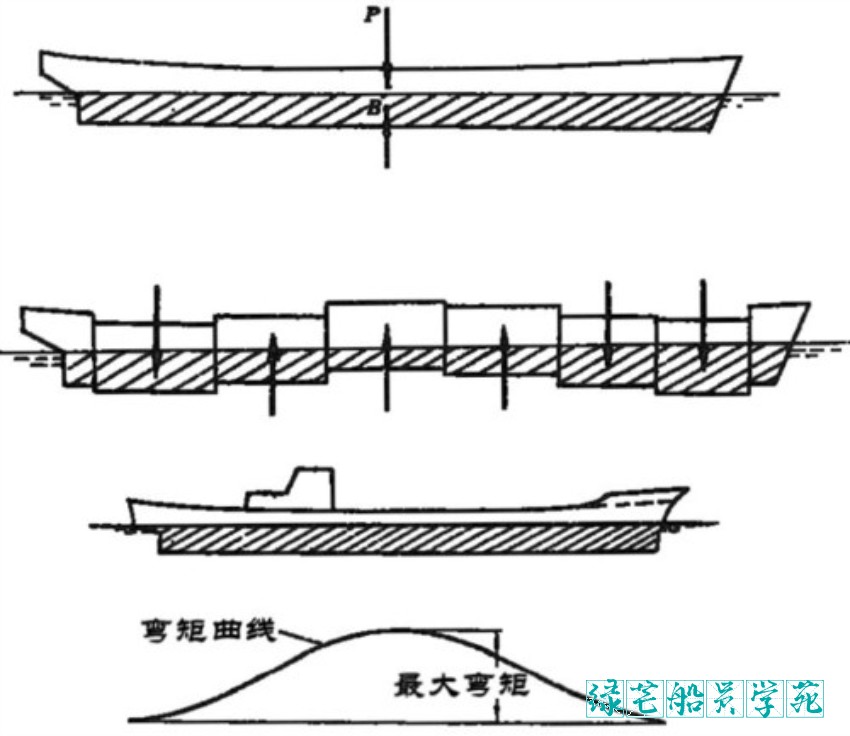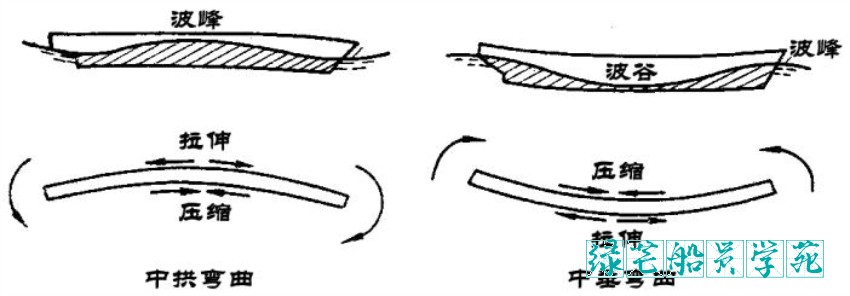船体强度|船体受力
小知识:什么是船体强度?
船体强度指船舶的船体结构在规定条件下能抵抗各种外力、不致造成严重变形或破坏的能力。
Hull strength refers to the ability of a ship's hull structure to resist various external forces under specified conditions without causing serious deformation or damage.
研究船体强度,就是为了保证所设计和建造的船舶在受到各种外力作用时,能在满足设计要求的前提下安全航行。
船体受力forces on hull/ship
船体受力是指作用在船体上的力。主要有三类:总纵弯曲力、横向载荷和其它局部力。
01总纵弯曲力longitudinal bending
船体的总纵弯曲是指作用在船体上的重力、浮力、波浪水动力和惯性力等引起的船体绕水平横轴的弯曲,总纵弯曲由静水总纵弯曲和波浪总纵弯曲两部分叠加而成。
(1)静水总纵弯曲longitudinal bending in still water
船舶在静水中受到的外力有船舶及其装载的重力和水的浮力。
The external forces on a ship in still water are the gravity of the ship and its load and the buoyancy of the water.

重力的方向向下,浮力的方向向上。重力和浮力在静水中处于平衡状态,即重力和浮力大小相等方向相反,作用在同一铅垂线上。
(2)波浪总纵弯曲longitudinal wave bending
指船舶在波浪中由于浮力和重力的不平衡而产生的弯曲。
"Longitudinal wave bending" means the bending of a ship in waves due to the imbalance of gravity against buoyancy.

船体在水中除了受静水总纵弯曲外,还受到波浪的影响,引起波浪总纵弯曲。有波浪时,船体内产生的弯矩较静水中更大。一般认为波浪长度等于船长时,船体的弯曲最为严重。当波峰在船中时,会使船体中部向上弯曲,形成中拱弯曲(Hogging);当波谷在船中时,会使船体中部向下弯曲,形成中垂弯曲(Sagging)。
02横向载荷transverse load
船体在静水或波浪中,它的各部分结构还受到局部的水压力和货物等横向载荷,会产生局部弯曲。
When the hull of a ship is in still water or waves, parts of the structure is also subject to transverse loads such as cargo and localized water pressure, which may produce localized bending.
03其他局部力
作用在船体上的其它力还有:船体上机器和螺旋桨运转时的振动力,船艏的波浪砰击和水面漂浮物的撞击等局部外力,油船的油货舱内液体的晃动载荷,以及船舶进坞或搁浅时受到船底下墩木或河床的反力作用等。这些力会使船体发生局部弯曲变形。
- 发表于 2023-12-01 12:55
- 阅读 ( 497 )
你可能感兴趣的文章
相关问题
0 条评论
文件生成中...
请稍候,系统正在生成您请求的文件

船体强度|船体受力

扫码过程中请勿刷新、关闭本页面,否则会导致支付失败
购买后请立即保管好,30天后需重新付费。

船体强度|船体受力

扫码过程中请勿刷新、关闭本页面,否则会导致支付失败
购买后请立即保管好,30天后需重新付费。
请点击下载或复制按钮进行操作
